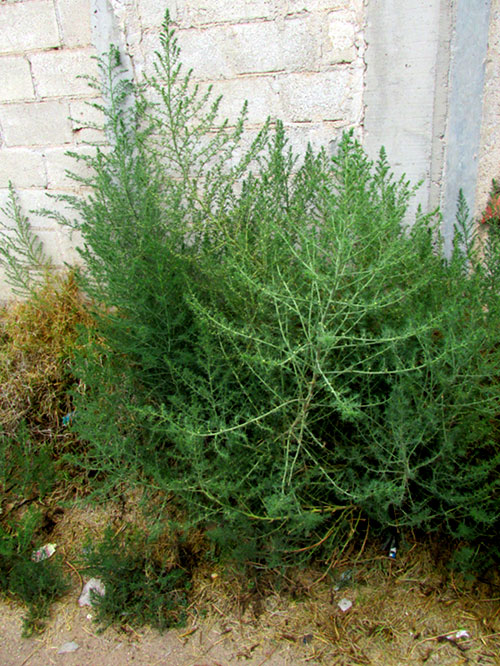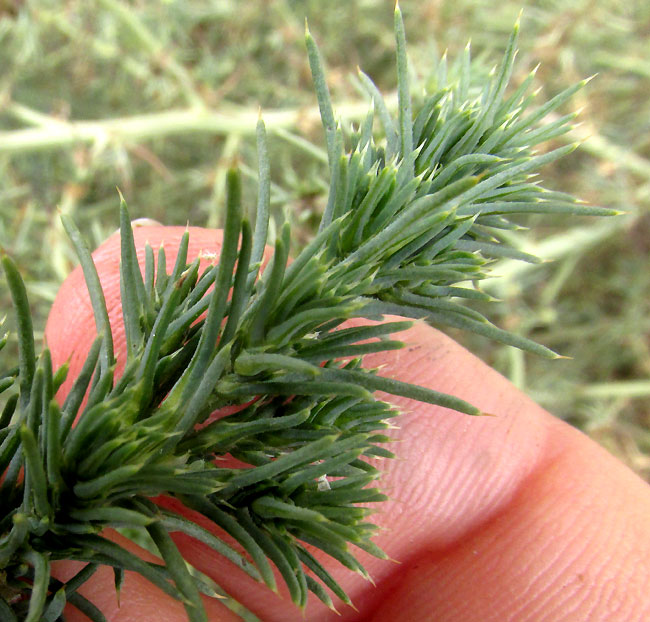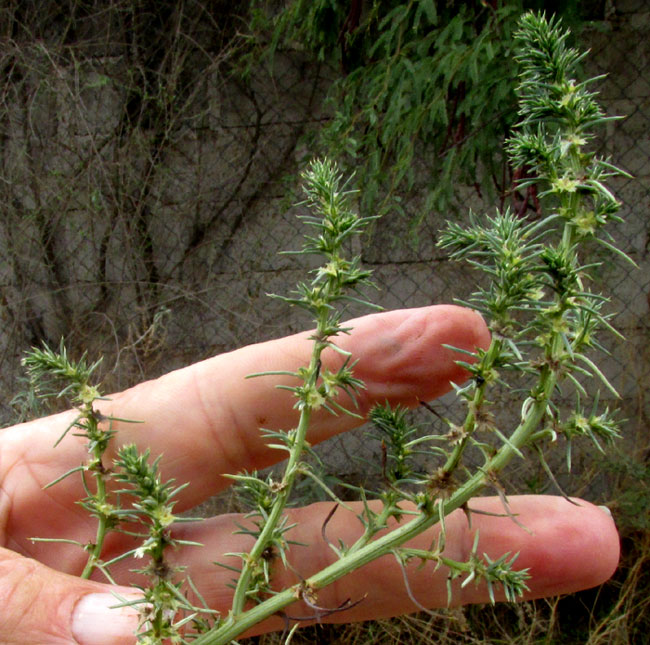Excerpts from Jim Conrad's
Naturalist Newsletter
entry dated June 22, 2022, issued from near Tequisquiapan, elevation about 1,900m (6200 ft), N20.565°, W99.890°, Querétaro state, MÉXICO
RUSSIAN THISTLE

Beside a wall along a dirt road in the town's outskirts, a vigorous, sprawling weed nearly 2m tall (6ft) had claimed its spot in the sun and rubbish. Up close, its stiff leaves were like crammed-together spruce needles, with hard, sharp prickles at their tips, explaining why wandering livestock hadn't chewed it down:

Upper stem tips were loaded with flowers and fruits, though you had to look closely to see them:

Below, a pollinated flower has already lost its stamens and its ovary is expanding into a hard, pointy fruit surrounded by a frilly collar:

In this kind of flower the usually-green calyx and usually-colorful corolla are replaced by an undifferentiated, papery, wing-like structure called a perianth. The whole perianth is about 8mm wide (1/3inch). Below you see how the above structure matures into a one-seeded fruit ready for dispersal:

The perianth serves as a kind of wing that can catch a breeze and waft the fruit away.
This is the Russian Thistle, SALSOLA TRAGUS, an invasive which plant historians tell us probably was introduced into the US in 1870 or 1874, in flaxseed imported from Russia. Now it's occupied nearly all its potential distribution area in North America. In Mexico it's also common in many places and still may be advancing into new territory. One reason for its expansion is that sometimes in arid ranchland areas it's cultivated as forage for livestock.
Not only are Russian Thistle robust, aggressive plants, but also the species appears to be producing experimental races wherever it goes. The Flora of North America describes the species as "extremely polymorphic consisting of several more or less distinct races (subspecies or segregate species)." Genetic sequencing indicates that in North America at least two "cryptic genetically divergent populations" are present, a cryptic population being one whose members have genes more closely matching a population other than they one they're currently assumed to belong to.
Russian Thistles aren't "real thistles," if we define a thistle as one of those very spiny members of the Composite/Aster Family producing parachuted one-seeded fruits that fly away on the wind. Russian Thistles are members of the Amaranth Family.
Tumbleweeds, on the other hand, are any of a number of species in the genus Salsola, to which Russian Thistles belong. Thus once our big plant matures and is loaded with fruits, the plant body will dry up, its sprawling branches will curve upward to form a plant body somewhat spherical shape, the body will break from its roots, and the wind will roll the ball-shaped plant across the landscape, any fruits that haven't already been blown or knocked off, being dispersed along the way.
Russian Thistles seem primed to prosper during the upcoming planetary ecological catastrophe. It's wind pollinated so doesn't need those insects now facing extinction, it's drought tolerant, spreads fast and far into wastelands, and thrives among trashy ruins.